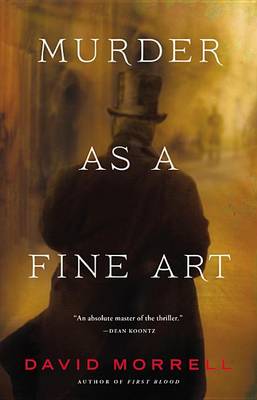Reviewed by brokentune on
I love the cover of this book! Murder as a Fine Art has been on my "currently reading" shelf for months just so I could admire the cover art.
I also love the premise of Thomas De Quincey (the author best known for Confessions of an English Opium Eater) investigating a murder in Victorian London.
A premise like this just screams "fun read", I thought. And then I got stuck just 23% into the book.
Why?
1. Even though the idea behind Murder as a Fine Art is brilliant, the writing doesn't quite pull off a Victorian crime drama featuring a highly intelligent sleuth complete with side-kick. It reminds too much of a Holmes and Watson mystery - and there were a few scenes that reminded me so much of Holmes' adventures that I wanted to abandon the book and re-read Arthur Conan Doyle.
2. When I read a Victorian mystery set in London, I want to be drawn into a time-warp and find myself in Victorian London. It's possible. ACD did it with Holmes and Marie Belloc Lowndes managed to transport me to the Baker Street area in The Lodger. Morrell spends a great deal of time specifying which streets the action takes place in, and having a fair understanding of London - I can easily picture the geography. But while Morrell tells us the street names, he does not show us the what the settings are like. It makes it hard to feel the atmosphere. And don't get me started on the incessant references to the "fog" because apparently everything becomes Victorian by the mere mention of a ubiquitous fog. (Yes, I counted 103 mentions of the fog.)
3. Some of the dialogue is rather silly. Two of my favourite examples are:
- “Our only amusement was to wait for the organ grinder to wheel his instrument onto this corner. The player always pretended that the organ weighed three times more than it actually did. When he turned the crank, he strained his face and breathed with difficulty, making it seem that turning the crank was the hardest job in the world."
Well, considering that "the crank" was a popular punishment in Victorian prisons, the organ grinder may have had a point.
- "The door was open. Fog drifted in, hovering around a man whose features had the color and grain of mahogany . He was extremely tall — taller even than Becker. He wore an oddly shaped head cover, gray, that Becker took a moment to remember from a drawing he’d seen in a newspaper . A turban, he thought it was called.
Despite the cold night, the newcomer’s only garments were a long, billowy shirt hanging over equally billowy trousers. Of Oriental design, they too were gray. Other than in the Illustrated London News, Becker had never seen anything like them. Apart from diplomats and military personnel stationed in India or other parts of the subcontinent, almost no one in England had ever encountered them. Emily stood to the side of the shop, lowering her hands from her face.
“I’m sorry. The door suddenly opened. When he appeared, I didn’t know what was happening. I’ve never seen . . .”
“A Malay,” De Quincey said."
A Malay from India with a turban? Erm, ... could do better on research, me thinks.
4. Structure: After my initial sticking point, I got stuck a second time at around 60%, because this is where the mystery is resolved - had I paid more attention I probably could have pieced it together earlier, but I had lost interest in the mystery element of the book early on. So, the rest of the book is concerned with catching the murderer.
To me it seems odd to have such break in the story. Once the mystery is resolved, there is little left to read on for.
Now for the good part - I still liked the book - just not as a mystery. Actually, the aspect I enjoyed most is the background information that was worked into the story and which by and large distracted from the mystery.
I would not go so far as to call it "info-dump" but the amount of background information given in the book is phenomenal. Not only do we get to know about Thomas de Quincey, but much of the story only works because it provides information about the politics and society of Victorian England and the history of the opium wars. The bits about Victorian burial rites, the medical uses of laudanum, Thugs, prison reform, etc. are just icing on the history-lover's cake.
Reading updates
- Started reading
- 4 May, 2014: Finished reading
- 4 May, 2014: Reviewed
